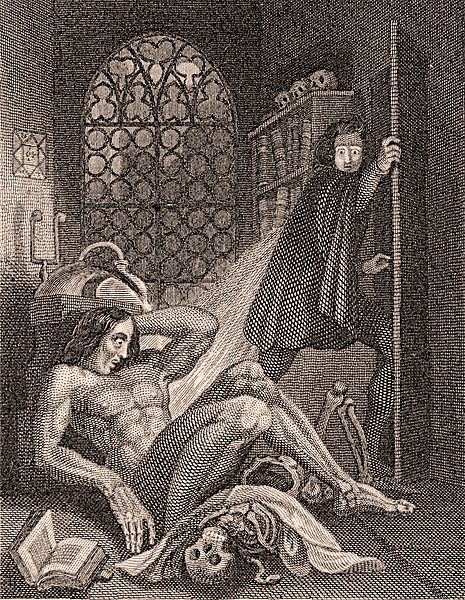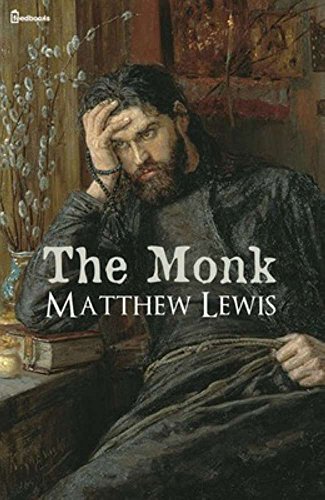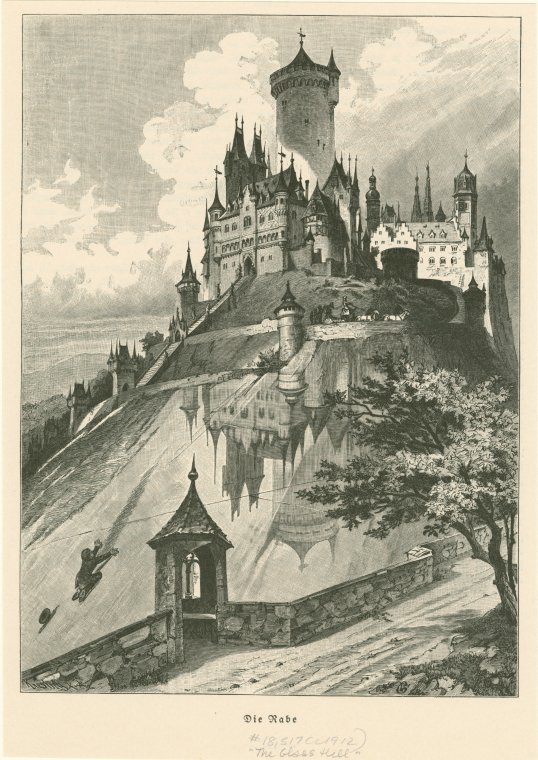If you are using Chrome, click the red hand button at the top right of the screen:

Then select: Don't run on pages on this site
If you do it correctly, the red hand will turn to green and you will no longer see this message.

This is the next roman you must read if you are following my free Gothic Literature Course: The Monk.

"The Monk: A Romance" is a Gothic novel by Matthew Gregory Lewis, published in 1796. It is a prime example of the male Gothic that specialises in the aspect of horror.
This novel was written by this British writer, born in 1775, at the age of 19 and already a member of Parliament and dedicated to Diplomacy. It is said that it took only ten weeks to write it. It would be published in 1796, which would lead us to place it in the preliminary stage of Gothic literature. As a curiosity, it should be noted that Lewis set his novel in Spain without having visited this country, based only on the stories of travelers who he had chatted in Holland. Anyway, he came very close to the Spanish social, urban and religious situation at the time. This imaginative resource leads us to think of our admired Ann Radcliffe who, in "The Mysteries of Udolfo" would describe a detailed tour of the French Languedoc, Provence and northern Italy, places she never visited.
Lewis did not sign the first edition of The Monk with his name, in part aware of the great criticism that he made about the hypocrisy of the Catholic Church; in part, due to the little consideration that the "Gothic novel" had at the time. It would be in subsequent editions that, given the success, his real name would appear.
It is not easy to make a brief synopsis of this great novel. In a very brief "summary" we would say that the novel introduces us to a Spanish monk, Ambrosio, a virtuous and elevated religious and highly revered by the people thanks to his loquacity. His "holiness in life" will, however, be the occasion of falling into the most subtlest and most powerful of temptations. No, we are not talking about sex, but about pride and vanity, the prelude to the rest of the disorders. And, thus, once the devil has access to the religious due to his fall into vanity, the rest will be "a piece of cake": first Matilda and her carnal seductions, then, when that temptation is satisfied, he will become obsessed with the innocent Antonia, unfortunate lady who will end her days under the hypocritical condemnation of the Monk. Ambrosio sins, yes, but at the same time he judges and punishes the "mistakes" of others, as he will cruelly do to Inés... Finally, Ambrosio, condemned to die at the hands of the Inquisition, manages to escape punishment at the cost of selling his soul to the devil. Lovely, isn't it?
In between, as was the case in many novels of the time, other secondary and even third stories intersect, such as the delightful story of the Bloody Nun which, by itself, would well deserve a crowned throne in the history of Gothic literature.
But let's back to the Monk. What does Lewis want apart from entertaining and thrilling? I think that fundamentally it was proposed to denounce the hypocritical situation of the Catholic Church at the time (and later). So hard was his criticism that Lewis had to soften, as we said before, the subsequent editions of his novel, since it was the occasion of a great scandal. It is a bit out of the scope of this blog, but it would be a good exercise to reflect on whether such criticism would still be relevant today.
Why do we say The Monk is a gothic novel? Well, there are no doubts about the gothic nature of this novel, since it contains the basic characteristics to be cataloged as it:
- It causes "uncanny". The reader gets into the novel and cannot prevent a chill, running down his back, when he imagines Inés in her forced prison, when diabolical powers facilitate Ambrosio's access to Antonia, when the burning of the convent of Santa Clara, when the story of the Bloody Nun is told... is, without a doubt, a constant. What about the episode of Inés in the catacomb, hugging her dead baby?
- The narration takes place in enclaves typical of "Gothicism", a monastery, a castle in the story of the Bloody Nun, a cemetery...
- Atmosphere of mystery and suspense, in particular, when descending to the crypt, or in everything that surrounds the monastery.
- There is no shortage of runaway emotions in the characters, typical of the time.
- Without a doubt, there are clear moments of eroticism. Latent eroticism, since Lewis had enough with his criticism of the Church to deal with this topic as well.
- The supernatural element that, we are no longer talking about a ghost, a zombie or a vampire... childish! In El Monje he will be his Diabolical Majesty in person: the devil, whose leading role will be habitual throughout the novel.
There are innumerable characters in this novel and I recommend doing the reading accompanied by paper and pencil. Some characters appear with more than one name because they dress up, they are who they do not say they are, but later it turns out that they are, and similar plots: Ambrosio, Antonia and aunt Leonila, Lorenzo de Medina and Cristóbal -count of Osorio-, Inés, Rosario -a novice who will later turn out to be not him but her, named Matilde-, the Marquis of Las Cisternas or Alfonso de Alvarado or Ramón, Elvira -Antonia's mother-, etc.
Remember Anne Radcliff (Udolfo's Mysteries) for the introduction of each chapter with a poem although, unlike Radcliff, her prose is more agile and it is therefore a novel that "usually likes"
In summary, without a doubt it is a highly recommended novel, especially if you are doing a chronological study or reading of Gothic literature. By the way, not much has been taken to the movies, perhaps due to the difficulties of adapting the script. There is a 2011 French film that is not bad, although it has a big flaw from my point of view: Inés dies almost at the beginning and is a fundamental character in the novel: without Inés there is no Abbess, without Inés the personality of Ambrosio remains modified. Can't miss Ines!
This is the second book I recommend to read for my Course of Gohtic Literature.

Of course, you can be thinking that I promise to writte about a different book once a week... and not. Well, consider that time in Spiritual World is different that time in Material World. (In this sense, I recommend to read the Summa Theologica, by Saint Thomas de Aquino, who speaks about some certain spiritual world named as "evo" (aevun, in latin). Evo is the succession of acts of understanding and will in a spiritual being which, in a certain sense, causes a before and after.
The Mysteries of Udolpho, by Ann Radcliffe, appears in four volumes on 8 May 1794. Her fourth and most popular novel, tells of Emily St. Aubert, who suffers misadventures that include the death of her mother and father, supernatural terrors in a gloomy castle, and machinations of an scoundrel Italian brigand. Often cited as the archetypal Gothic novel, The Mysteries of Udolpho appears prominently in Jane Austen's 1817 novel Northanger Abbey, where an impressionable young woman reader comes to see friends and acquaintances as Gothic villains and victims, with amusing results. For that reason it is said that The Mysteries of Udolpho is a quintessential Gothic romance, replete with incidents of physical and psychological terror: remote crumbling castles, seemingly supernatural events, a brooding, scheming villain and a persecuted heroine.
But, according to my own introduction, let's analyze why we can consider this roman as Gothic:
- The story is set in a tenebrous castle, important sign of gothity. However, modern critics note that only about a third of the novel is set in the eponymous Gothic castle, while tone and style vary markedly between sections of the work, to which Radcliffe added extended descriptions of exotic landscapes in the Pyrenees and Apennines, and of Venice, none of which she had visited. For details she relied on travel books, which led her to make several anachronisms (the name of local coins, for example). The novel, set in 1584 in Southern France and Northern Italy, explores the plight of Emily St. Aubert, a young French woman orphaned by the death of her father. She is imprisoned in Castle Udolpho by Signor Montoni, an Italian brigand who has married her aunt and guardian Madame Cheron. He and others frustrate Emily's romance with the dashing Valancourt. Emily also investigates a relationship between her father and the Marchioness de Villeroi, and its connection to Castle Udolpho.
- We apreciate around all the book a fear, inquietant and dark atmposphere. The uncanny fact is there.
- There are surprises in the family lineage of the protagonists.
- We can find overwhelmed emotions. We are in the 19th century and the female protagonists suffer access to tears, fainting, shakes, convulsions, illnesses that will prostrate them in bed for entire months, etc. I really love those gothic illnesses.
- Eroticism? Not even remotely! And I must say that here we find a severak anachronism: In sixteenth-century, at France, kings, queens nobles and clergymen were nothing if they didn't have five or six lovers -of both sexes-. However Emily, our poor Emily -who was ahead of her time- displayed a radical Anglican Puritanism.
So, we can afirm this roman is gothic. But now the terrible question: would I recommend this novel to a friend?
Personally, I am afraid I must reproduce the answer I gave with the Castle of Otranto. I wouldn't recommend it to someone who doesn't know what to read, but I would recommend it to someone who is studying Gothic literature and, above all, who has a lot of time and some patience. Obviously, the eternal description of landscapes, characters and psychologies gives us a good idea of the influence of nineteenth-century romanticism on Gothic culture. This is more important than it may seem: When we discuss why a goth man or woman is more individualistic, they feel disappointed by the various types of human groups (associations, religious communities, clubs, states, etc.), when one wonders why the attire of a goth person or his sympathy for the alternative, or when he seeks during years for an ideal love, but suffers because reality denies him... perhaps we should look back at the personality of the men and women of the 19th century, at their reaction to feelings against the rationalism of the eighteenth century, the exaltation of sensibilities.
So, please, do read The Mysteries of Udolpho.
COMMENTS
-